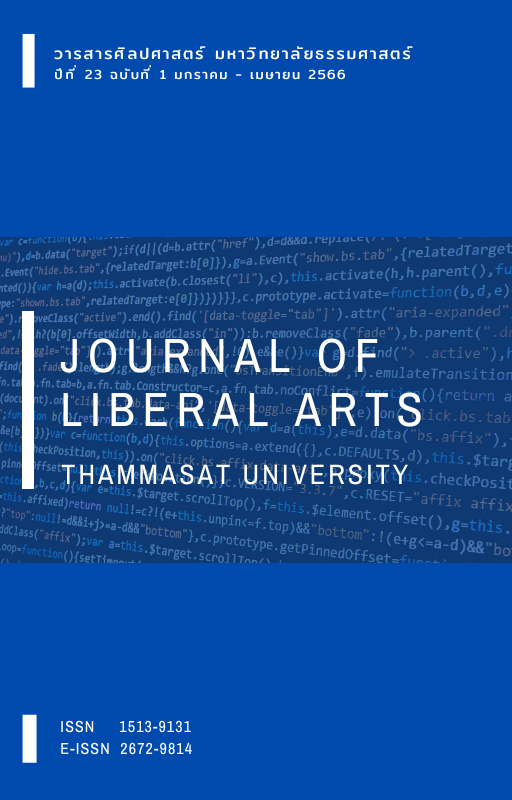A Move Analysis of Happily-Ever-After Women’s Fiction Blurbs: Classic vs. Mass-Marketed Novels
Main Article Content
บทคัดย่อ
Based on Gea-Valor (2005), Cacchiani (2007) and Önder (2013), this study explored the nature of moves in 40 classic (CL) and 40 mass-marketed (MM) blurbs from happily-ever-after women’s novels written or translated into English. The three research questions were: (1) What were the obligatory, conventional and optional moves in the CL and MM? (2) What were the high-frequency steps in both types, in the CL, and in the MM? and, (3) Which steps showed large differences between the CL and MM? Which steps were unique to the CL and MM? The results can be summarized as follows: First, two obligatory moves in the M2 book description were found in both types of blurbs and the M6 technical information was found only in the MM. Conventional moves populated most of the rest, along with a few of the optional moves, with M4 author’s credentials having the lowest figure. Next, regarding both types’ 17 notable steps in the six moves, the top three were M5.3 magazines and newspapers, M4.3 literary accomplishments, and M3.1 content. Finally, nine unique steps were found. The CL’s six included, from high to low, M3.5 direct compliments, M1.5 excerpts, M2.1.2 background with evaluation, M4.1 date/place of birth/death, M3.3 literary theory and style and M6.4 translator/introduction writer’s info while the MM’s three steps were M6.1 author’s contacts, M4.5 personal life, and M2.4 curiosity arousers. It is hoped that discourse analysts and EFL practitioners would benefit from this paper.
Downloads
Article Details

อนุญาตภายใต้เงื่อนไข Creative Commons Attribution-NonCommercial-NoDerivatives 4.0 International License.
เอกสารอ้างอิง
Amnuai, W., & Wannaruk, A. (2013). An analysis of moves in introductions in international and Thai journal research articles. PASAA, 45, 61-90.
Asghar, Z. M., Mahmood, M. A., & Asghar, S. A. (2015). Generic structure of the blurbs in Pakistani E-socio-romantic novels. Journal of Education and Practice, 6(4), 158-168.
Bhatia, V. (2005). Generic patterns in promotional discourse. In H. Halmari, & T. Virtanen (Eds.), Persuasion across genres: A linguistic approach (pp. 213-228). John Benjamins.
Bhatia, V. (2014). Analyzing genres: Language use in professional settings. Routledge.
Burnett, J. (2010). Generations: The time machine in theory and practice. Ashgate.
Cacchiani, S. (2007). From Narratives to intensification and hyperbole: Promotional uses of book blurbs. In M. Davies et al. (Eds.) Proceedings of the Corpus Linguistics Conference, University of Birmingham, 27-30 July 2007. www.corpus.bham.ac.uk/corplingproceedings07/paper/79_Paper.pdf
Chaidej, C., & Pupipat, A. (2021). Move analysis of women and men’s personal care product online advertisements. Journal of Studies in the English Language, 16(2), 22-51.
Cronin, B., & La Barre, K. (2005). Patterns of puffery: An analysis of non-fiction blurbs. Journal of Librarianship and Information Science, 37(1), 17-24.
Crystal, D. (2010). The Cambridge encyclopedia of language (3rd ed.). Cambridge University Press.
Devitt, A. (2015). Genre performances: John Swales’ genre analysis and rhetorical-linguistic genre studies. Journal of English for Academic Purposes, 19, 44-51.
Eagle, L., Czarnecka, B., Dahl, S., & Lloyd, J. (2021). Marketing communications (2nd ed.). Routledge.
Eagleton, T. (2013). How to read literature. Yale University Press.
Egan, J. (2023). Marketing communications (4th ed.). Sage.
Flowerdew, J. (2013). Discourse in English language education. Routledge.
Gao, S., & Pramoolsook, I. (2021). Move-step structure of the results and discussion section of electronic engineering research articles written by Chinese and Thai researchers. Journal of Teaching English for Specific and Academic Purposes, 9(4), 725-739.
Gea-Valor, M. L. (2005). Advertising books: A linguistic analysis of blurbs, Ibérica, X, 41-62.
Hebron, M. (2004). Mastering the language of literature. Palgrave Macmillan.
Hyland, K. (2004). Genre and second language writing. The University of Michigan Press.
Jones, R. H. (2019). Discourse analysis: A resource book for students (2nd Ed.). Routledge.
Kotler, P., Armstrong, G., & Opresnik, M. O. (2018). Principles of marketing (17th ed.). Pearson.
McMurtry, J. M. (2023). Marketing for dummies (6th ed.). John Wiley & Sons.
Önder, N. (2013). Generic structure and promotional elements in best-selling online book blurbs: A Cross-Cultural Study. Ibérica, 25, 171-194.
Paltridge, B. (2012). Discourse analysis (2nd ed.). Bloomsbury.
Pramoolsook, I., & Yaemwannang, C. (2020). A comparison of rhetorical move structures of hotel, restaurant, and tourist destination homepages. ABAC Journal Assumption University, 40(3), 27-53.
Pupipat, A. (1998). Scientific writing and publishing in English in Thailand: The perception of Thai scientists and editors [Unpublished doctoral dissertation]. Columbia University.
Pupipat, A. (2023). Should a book be judged by its back cover? Some written/formal features as observed in happily-ever-after women’s novel blurbs,” LEARN Journal: Language Education and Acquisition Research Network, 16(1), 604-630.
Pupipat, A., Rungkaew, T, & Meeparp, L. (2022). Judging a book by its back cover: Spoken/informal register as found in happily-ever-after women’s novel blurbs. Journal of Studies in the English Language, 17(2), 1-31.
Swales, J. M. (2004). Research genres: Explorations and applications. Cambridge University Press.
Yathip, C., & Soranastaporn, S. (2016). A comparison of moves and the sequence of moves in research abstracts in standard and predatory journals. Journal of English Studies, 11, 88-125.


